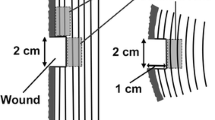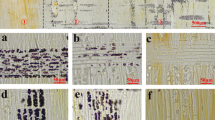Abstract
We monitored the distribution of death of secondary xylem cells in a conifer, Abies sachalinensis. The cell death of tracheids, which are tracheary elements, occurred successively and was related to the distance from cambium. Thus, it resembled programmed cell death. By contrast, the death of long-lived ray parenchyma cells had the following features: (1) ray parenchyma cells remained alive for several years or more; (2) in many cases, no successive cell death occurred even within a given radial cell line of a ray; and (3) the timing of cell death differed among upper and lower radial cell lines and other lines of cells within a ray. These results indicate that the death of long-lived ray parenchyma cells involves a different process from the death of tracheids. The initiation of secondary wall formation and the lignification of ray parenchyma cells in the current year's annual ring were delayed in the upper and lower radial cell lines of a ray. In addition, the density of distribution and orientation of cortical microtubules in such cells were different from those in cells in other radial lines. Ray parenchyma cells in the previous year's annual ring within the upper and lower radial cell lines of a ray contained many starch grains. Our results indicate that positional information is an important factor in the control of the pattern of differentiation and, thus, of the functions of ray parenchyma cells that are derived from the same cambial ray cells.






Similar content being viewed by others
References
Abe H, Funada R (2005) The orientation of cellulose microfibrils in the cell walls of tracheids in conifer: a model based on observations by field emission-scanning electron microscopy. IAWA J 26:161–174
Abe H, Funada R, Imaizumi H, Ohtani J, Fukazawa K (1995a) Dynamic changes in the arrangement of cortical microtubules in conifer tracheids during differentiation. Planta 197:418–421
Abe H, Funada R, Ohtani J, Fukazawa K (1995b) Changes in the arrangement of microtubules and microfibrils in differentiating conifer tracheids during the expansion of cells. Ann Bot 75:305–310
Baskin TI (2001) On the alignment of cellulose microfibrils by cortical microtubules: a review and a model. Protoplasma 215:150–171
Bamber RK, Fukazawa K (1985) Sapwood and heartwood: a review. For Abstract 46:567–580
Catesson AM (1990) Cambial cytology and biochemistry. In: Iqbal M (ed) The vascular cambium. Research Studies Press, Taunton, pp 63–112
Chaffey N (1999) Cambium: old challenges – new opportunities. Trees 13:138–151
Chaffey N (2002) Why is there so little research into the cell biology of the secondary vascular system of trees? New Phytol 153:213–223
Chaffey N, Barlow P (2001) The cytoskeleton facilitates a three-dimensional symplastic continuum in the long-lived ray and axial parenchyma cells of angiosperm trees. Planta 213:811–823
Chaffey NJ, Barlow PW, Barnett JR (1997) Cortical microtubules rearrange during differentiation of vascular cambial derivatives, microfilaments do not. Trees 11:333–341
Demura T, Tashiro G, Horiguchi G, Kishimoto N, Kubo M, Matsuoka N, Minami A, Nagata-Hiwashita M, Nakamura K, Okamura Y, Sassa N, Suzuki S, Yazaki J, Kikuchi S, Fukuda H (2002) Visualization by comprehensive microarray analysis of gene expression programs during transdifferentiation of mesophyll cells into xylem cells. Proc Natl Acad Sci USA 99:15794–15799
Fukazawa K, Higuchi T (1966) Studies on the mechanism of heartwood formation. 4. RNA content in the ray parenchyma cell. Mokuzai Gakkaishi 12:221–226
Fukuda H (1997) Tracheary element differentiation. Plant Cell 9:1147–1156
Fukuda H (2004) Signals that control plant vascular cell differentiation. Nature Rev Mol Cell Biol 5:379–391
Fukuda H, Komamine A (1980) Establishment of an experimental system for the tracheary element differentiation from single cells isolated from the mesophyll of Zinnia elegans. Plant Physiol 65:57–60
Funada R (2000) Control of wood structure. In: Nick P (ed) Plant microtubules: potential for biotechnology. Springer, Heidelberg, pp 51–81
Funada R (2002) Immunolocalisation and visualisation of the cytoskeleton in gymnosperms using confocal laser scanning microscopy (CLSM). In: Chaffey N (ed) Wood formation in trees: cell and molecular biology techniques. Taylor and Francis Publisher, London, pp 143–157
Funada R, Abe H, Furusawa O, Imaizumi H, Fukazawa K, Ohtani J (1997) The orientation and localization of cortical microtubules in differentiating conifer tracheids during cell expansion. Plant Cell Physiol 38:210–212
Funada R, Furusawa O, Shibagaki M, Miura H, Miura T, Abe H, Ohtani J (2000) The role of cytoskeleton in secondary xylem differentiation in conifers. In: Savidge R, Barnett J, Napier R (eds) Molecular and cell biology of wood formation. BIOS Scientific Publishers, Oxford, pp 255–264
Funada R, Miura H, Shibagaki M, Furusawa O, Miura T, Fukatsu E, Kitin P (2001) Involvement of localized cortical microtubules in the formation of modified structure of wood. J Plant Res 114:491–497
Hillis WE (1987) Heartwood and tree exudates. Springer-Verlag, New York, pp 1–268
Kuriyama H, Fukuda H (2002) Developmental programmed cell death in plants. Curr Opin Plant Biol 5:568–573
Magel E (2000) Biochemistry and physiology of heartwood formation. In: Savidge R, Barnett J, Napier R (eds) Molecular and cell biology of wood formation. BIOS Scientific Publishers, Oxford, pp 363–376
Murakami Y, Funada R, Sano Y, Ohtani J (1999) The differentiation of contact cells and isolation cells in the xylem ray parenchyma of Populus maximowiczii. Ann Bot 84:429–435
Nobuchi T, Kuroda K, Iwata R, Harada H (1982) Cytological study of the seasonal features of heartwood formation of sugi (Cryptomeria japonica D. Don). Mokuzai Gakkaishi 28:669–676
Nobuchi T, Takahara S, Harada H (1979) Studies on the survival rate of ray parenchyma cells with ageing process in coniferous secondary xylem. Bull Kyoto Univ Forest 51:239–246
Sano Y, Nakada R (1998) Time course of the secondary deposition of incrusting materials on bordered pit membranes in Cryptomeria japonica. IAWA J 19:285–299
Sauter JJ (2000) Photosynthate allocation to the vascular cambium: facts and problems. In: Savidge R, Barnett J, Napier R (eds) Molecular and cell biology of wood formation. BIOS Scientific Publishers, Oxford, pp 71–83
Takabe K (2002) Cell walls of woody plants: autoradiagraphy and ultraviolet microscopy. In: Chaffey N (ed) Wood formation in trees: cell and molecular biology techniques. Taylor and Francis Publisher, London, pp 159–178
Watanabe Y, Sano Y, Asada T, Funada R (2006) Histochemical study of the chemical composition of vestured pits in two species of Eucalyptus. IAWA J 27:33–43
Yamamoto K (1982) Yearly and seasonal process of maturation of ray parenchyma cells in Pinus species. Res Bull College Exp For Hokkaido Univ 39:245–296
Yoshida M, Fujiwara D, Tsuji Y, Fukushima K, Nakamura T, Okuyama T (2005) Ultraviolet microspectrophotometric investigation of the distribution of lignin in Prunus jamasakura differentiated on a three-dimensional clinostat. J Wood Sci 51:448–454
Acknowledgements
The authors thank Professor S. Fujikawa for his valuable comments. Part of the present study was supported by a Grant-in-Aid for Scientific Research from the Ministry of Education, Science, Culture and Sport, Japan (no. 17580137).
Author information
Authors and Affiliations
Corresponding author
Additional information
Communicated by H. Ebinuma
Rights and permissions
About this article
Cite this article
Nakaba, S., Sano, Y., Kubo, T. et al. The positional distribution of cell death of ray parenchyma in a conifer, Abies sachalinensis . Plant Cell Rep 25, 1143–1148 (2006). https://doi.org/10.1007/s00299-006-0194-6
Received:
Revised:
Accepted:
Published:
Issue Date:
DOI: https://doi.org/10.1007/s00299-006-0194-6




